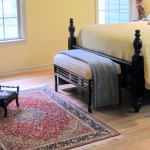I once had some friends get married and they combined two apartments full of stuff into one house.
What a design ‘train wreck’ that was – A maroon sofa with a turquoise coffee table…
Don’t feel bad if you’re a person who has difficulty with coordinating colors in a room. Lots of folks find this a challenge.
Good news is I have a valuable design secret for you. It’s a no-fail room color strategy that works every time.
The secret is called the Primary-3. Simply start with the three primary colors: red, yellow and blue. It’s a familiar and comfortable combination for pretty much everyone.
Now I don’t mean recreating your old nursery school room red dots and blue triangles. I mean graduating to a higher more stylish level.
Thanks to hue and tone, using just these three colors, your interiors can look great! You may not realize it but each and every color covers a full range from almost black to almost white.
Think about blue for instance. There’s navy blue so dark it is almost black. On the flip side, there’s pale ice-blue that can almost appear white. You get the idea?
Okay, so here are practical examples for you to follow on your next room makeovers. Start with a traditional oriental rug as your core inspiration – one already rich in reds and blues.
Next, add the main upholstered piece, like the sofa or bed spread. It could be either cranberry or navy.
Next, accent with yellow here and there. Maybe as gold damask upholstered chair seats or various sized throw pillows on the bed.
Once you have these in place, check out the dark/light balance of the room. Are all of your room color choices in a safe but bland middle range of colors? Ideally, you want the weight of something colored very dark, to offset something whose color is very light.
Now, if you think it’s too much color overall for your taste, here’s what you do. Add good-old dependable neutrals – beige, taupe, off-white, gray for large areas like walls and draperies.
The secret is to choose one of the three primary colors as the “boss” color in large amounts, then use a medium amount of the second color. Finally, use your third as the smaller dash of accent to give the room a bit of a punch!
For a bold playful contemporary look why not start with summer sky blue, add a scattering of banana yellow with a splash of fire engine red?
For a quiet sophisticated look take creamy yellow vanilla, accent with pink cotton candy, and splash with pale blueberry yogurt?
Pick up a free paint fan deck from the paint store and play with different combinations.
I’d love to hear what ‘primary-3’ colors are your favorites by leaving a comment here. Have fun!



{ 5 comments… read them below or add one }
It’s nice to have an easy guide to interior color. Beige usually rules because it’s hard to know how to choose a palette. Very helpful tips!
Uh… Red, green and blue are the primary colors.
As Larry points out, IF we were mixing light, then those primary colors would be red, green and blue.
In this case, since we’re mixing pigments, your primary color pallet is red, yellow and blue!
Hi there! I could have sworn I’ve been to this website before but after reading through some of the post I realized it’s new
to me. Anyhow, I’m definitely glad I found it and I’ll
be bookmarking and checking back often!
My brother recommended I might like this website.
He was entirely right. This post truly made my day.
You cann’t imagine simply how much time I had spent for this information! Thanks!